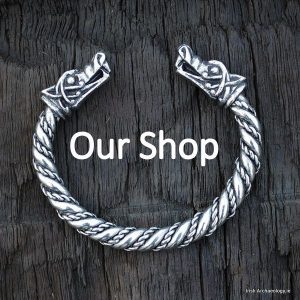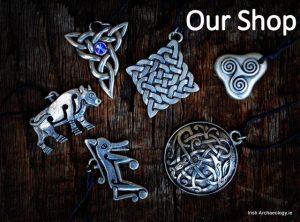Recent excavations by TVAS archaeology have uncovered the remains of a large neolithic house just outside Eniscorthy. Details below.
http://www.enniscorthyecho.ie/news/mhsngbidid/
Wexford’s oldest house’ uncovered at local site
WHAT IS being regarded by experts as the site of one the oldest residential homes in Co. Wexford dating back to 3600 BC has been discovered during an archaeological dig along the N30 Enniscorthy Clonroche road, just outside Enniscorthy town.
The discovery, in the townsland of Dunsinane, Templescoby, just a couple of miles from the town, dates back to the Neolithic period in Irish history. It was made during archaeological testing as part of work on the current ongoing Enniscorthy by-pass project, and has led to great excitement for all concerned.
The remains of the rectangular building, Crusheen, Co. Clare-based archaeology consultants TVAS (Ireland) Ltd. state, reveal a large and impressive structure was involved. The structure measures 14m east-west and 7m north-south.
According to Derek Gallagher of TVAS Archaeology, the site director at the Dunsinane dig, this is one of the most significant discoveries made in Ireland in recent years. He said, “There have been less than fifty early-Neolithic houses excavated in this country since they were first discovered at Lough Gur (Limerick) in 1939 by Seán P. Ó Riordáin.
“This particular one has extra significance in that it is intact and has yielded multiple finds of pottery and flint. It is actually at the large end of the scale for these house types, and is likely to have been a two-storey dwelling.” Archaeologist Emer Larkin points out that the Neolithic house found near Enniscorthy is unlike any other excavated before in Ireland.
Graham Hull, senior archaeologist with TVAS, says that 125 archaeological sites were found along the route of the N11 between Gorey and Enniscorthy during excavations on that section of the work, for which he was project manager for the archaeological investigations.
These were dug over the course of 2010 and into this year by a team that at one stage exceeded 130 archaeologists. He explains that, as often seems to be the case in archaeology, the best sites are usually found last, and that the Neolithic house at Dunsinane is destined to be the final dig on this particular road scheme.
The information gathered during the excavation dig is set to be analysed and examined by specialists, with their findings then compiled, available online from the end of this year at www.tvasireland.ie
The Echo has also learned that the soon-to-open new-look Co. Museum at Enniscorthy Castle is set to host a series of public lectures and exhibitions of these important findings next year, while a book containing details of this and other archaeological results will be published either next year or in 2013.
The archaeological works on the N11 Gorey-Enniscorthy road scheme is being funded by the NRA through Wexford Co. Council.
On behalf of all the archaeologists who worked on the scheme, Mr. Hull pays tribute to the various landowners involved for what he says was their great co-operation and goodwill during the digging-for-history programme during the roadworks project.
According to Derek Gallagher, the people living in the house located in the heart of what is now Co. Wexford over three thousand years ago would have been agricultural (farmers) types. They put a lot of effort into building the structure, he says, which would have stood out in the local landscape of the time.
“Even by today’s standards, the house required a huge amount of time and resources to build, bearing in mind that the only tools available were made from stone, wood, antler and bone.
“Large oak trees would have been felled, then split and dressed to make the planks for the walls. Foundation trenches were dug and tonnes of stone had to be gathered to place in the trenches. Reeds and grasses would have been needed to thatch the roof. “
Mr. Gallagher feels that because of its size, the house would have accommodated thirteen or more people. All the preparation would have taken a great deal of organisation and time, he says.
Emer Larkin says that the size of the house ‘would indicate a substantial dwelling for this period, within which a large family would comfortably live.’ In her opinion, the house also represents what was a large farming community in the area.
She says, “These finds help us relate to these people at a more personal level, such as the pottery used for eating and drinking, rubbing stones used for the preparation of food and clothing, and the flint arrowhead used for hunting and flint scrapers for cleaning and cutting animal hides.”
The Dunsinane discovery is the second early-Neolithic house uncovered in Co. Wexford in as many years through archaeological investigations carried out on behalf of the NRA during major roadworks projects. A smaller one was discovered some time ago outside New Ross.
According to the experts, these type of historical discoveries also highlight the cultural importance of archaeological investigations associated with road projects, as previously very little evidenc e of settlement of Co. Wexford have been discovered.
Local archaeologicist Vera Power, from Newtown, Taghmon, described the Dunsinane find as ‘revolutionary’, both for Wexford as well as Ireland. She stated, “It is an average category of house and the finds within are fantastic. I am amazed at the technology they had at the time.
“It makes you realise how advanced they were in the Neolithic period. This house is a big contribution to the archaeology of our county for instance, the size of the central post holes supporting the superstructure of the house is also significant, indicating the maturity of the native forests in the area, contemporary with the house itself.”



Great stuff. Glad to hear Wexford have one too :-). Should be 5000 years ago not 3000.
You got the love the local papers when it come to facts! 🙂
At last a blog on Irish Archaeology, great idea. I wish you all the best, and perhaps an income also, as a result, of all this work.
Thanks Kate!